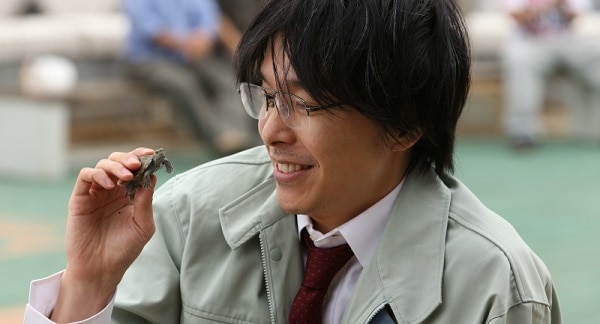
Written & Directed by Sion Sono
Japan, 2015
Love & Peace should not work. This fantasy-dramedy concoction from Japan’s mad genius, Sion Sono, combines absurdist comedy, serious drama, musical numbers, satire, and untold other genres in ways that simply shouldn’t be done. And yet, it works completely. What other film this year can make you laugh, cry, and feel inspired, all at the same time? Simply put, Love & Peace is one 2015’s best films and it demands to be seen.
Ryoichi Suzuki (Hiroki Hasegawa) is a loser. He failed as a rock singer, is mercilessly ridiculed at his thankless office job, and can’t even muster the courage to speak to his secret love, Yuko (Kumiko Aso). None of that stops him from having huge dreams, of course. With the Tokyo Olympiad approaching in 2020, Ryoichi dreams of performing in the newly-minted Nippon Stadium. He’ll ascend to rock-god status and then everyone will be sorry! Sadly, the only living creature willing to listen to Ryoichi’s delusional ranting is his new turtle, Pikadon (named after the atomic bomb).
The love affair between Ryoichi and Pikadon is bizarrely touching. The two become inseparable, with Ryoichi even smuggling him into work in his jacket pocket. Big mistake. Ryoichi is broken down by his taunting co-workers and, in a moment of desperation, flushes Pikadon down the toilet. Devastated by his own act of betrayal, Ryoichi can’t even recognize Yuko’s heartfelt attempts to comfort him. As for the flushed Pikadon, his adventure has just begun, as he makes his way to the underground refuge known as ‘Lost & Found Heaven.’
This is where the synopsis of Love & Peace must end. To divulge any further details would be a disservice.
 With Love & Peace, Sion Sono has taken the ‘vengeful loser’ sub-genre to giddy new heights. You can see echoes and influences everywhere, from Pee Wee’s Playhouse to kaiju classics, and even the moog rendition of Beethoven’s “Ninth Symphony” used in A Clockwork Orange makes numerous appearances. Yet, despite this hodgepodge of genres and styles, Sono has crafted something completely his own. This is a personal story, filled with big emotional flourishes and human yearning. Yes, Sono’s absurdist trademarks are still here, like close-ups of anguished faces and frenzied characters running through the streets, but none of that overshadows each character’s desperate need for love and acceptance.
With Love & Peace, Sion Sono has taken the ‘vengeful loser’ sub-genre to giddy new heights. You can see echoes and influences everywhere, from Pee Wee’s Playhouse to kaiju classics, and even the moog rendition of Beethoven’s “Ninth Symphony” used in A Clockwork Orange makes numerous appearances. Yet, despite this hodgepodge of genres and styles, Sono has crafted something completely his own. This is a personal story, filled with big emotional flourishes and human yearning. Yes, Sono’s absurdist trademarks are still here, like close-ups of anguished faces and frenzied characters running through the streets, but none of that overshadows each character’s desperate need for love and acceptance.
It’s also one of the most bat-shit crazy family films ever made. Yes, family film! Younger audiences will certainly relate to the enchanting characters from ‘Lost & Found Heaven,’ and anyone old enough to remember ‘The Island of Misfit Toys’ will have a huge grin on their face, as well. In a Bizarro World, Love & Peace would become a Christmas staple, espousing the same values of love and loyalty found in other treasured classics. With children bombarded by the constant refrain, “You can be anything you dream of being!” it’s refreshing to see a movie caution about the dangers of unfettered ambition. Will you recognize yourself when you achieve your dreams? Will you still like that person? It’s the type of simple, allegorical filmmaking that resonates with every age group.
Visually, Sono is in fine form. The special effects are solid enough to be convincing and dodgy enough to remain adorable, while the adorable elements are just creepy enough to prevent any sugary aftertaste. The crowning jewel, of course, is ‘Lost & Found Heaven,’ where Sono throws all of his surrealistic nightmares and cherished archetypes into one set design. The concert scenes are convincingly staged, too, with Ryoichi adopting a persona straight out of Ziggy Stardust’s playbook.
 Which brings us to the musical score…
Which brings us to the musical score…
Does Sion Sono have a ‘Greatest Hits’ compilation of soundtrack songs? If not, he really should. With the song, “Love & Peace,” Sono has crafted something infuriatingly catchy that never feels trite. The film’s other original songs, though less memorable, add to the overall themes and mood of the piece. And that pulsing opening note to Ludwig van’s glorious “Ninth” propels us into each scene with renewed momentum.
If Sono struggles with any element of his filmmaking it continues to be editing. The cuts between interspersing storylines are dodgy, which bogs down the otherwise rapid pace. Too often, Sono lingers on one thread at the expense of another. Perhaps this is a consequence of mixing such disparate genre elements, but it runs perilously close to feeling clunky and episodic. Luckily, the emotional core of the film, along with the memorable characters, keeps things on track.

Love & Peace is the type of exhilarating cinematic experience that keeps you coming back to the theater. It’s like nothing you’ve ever seen before, and yet it resonates with the familiar themes that sustain our humanity. Sion Sono’s unique vision never fails to fascinate, and with Love & Peace, he’s packing plenty of emotional punch, as well.

